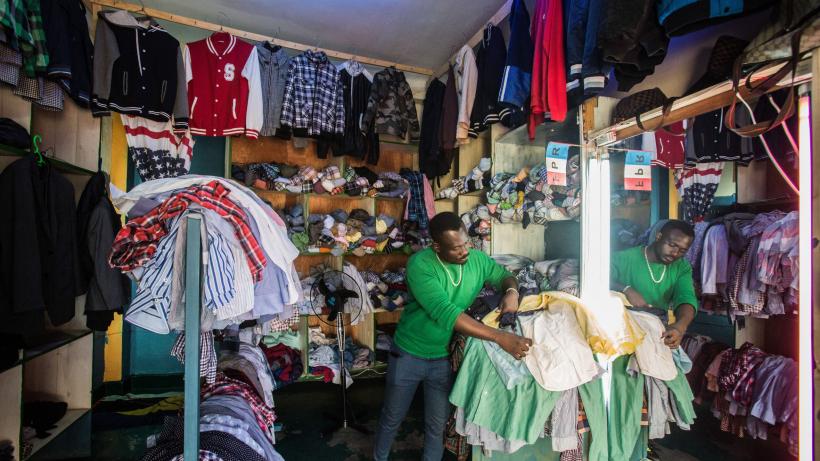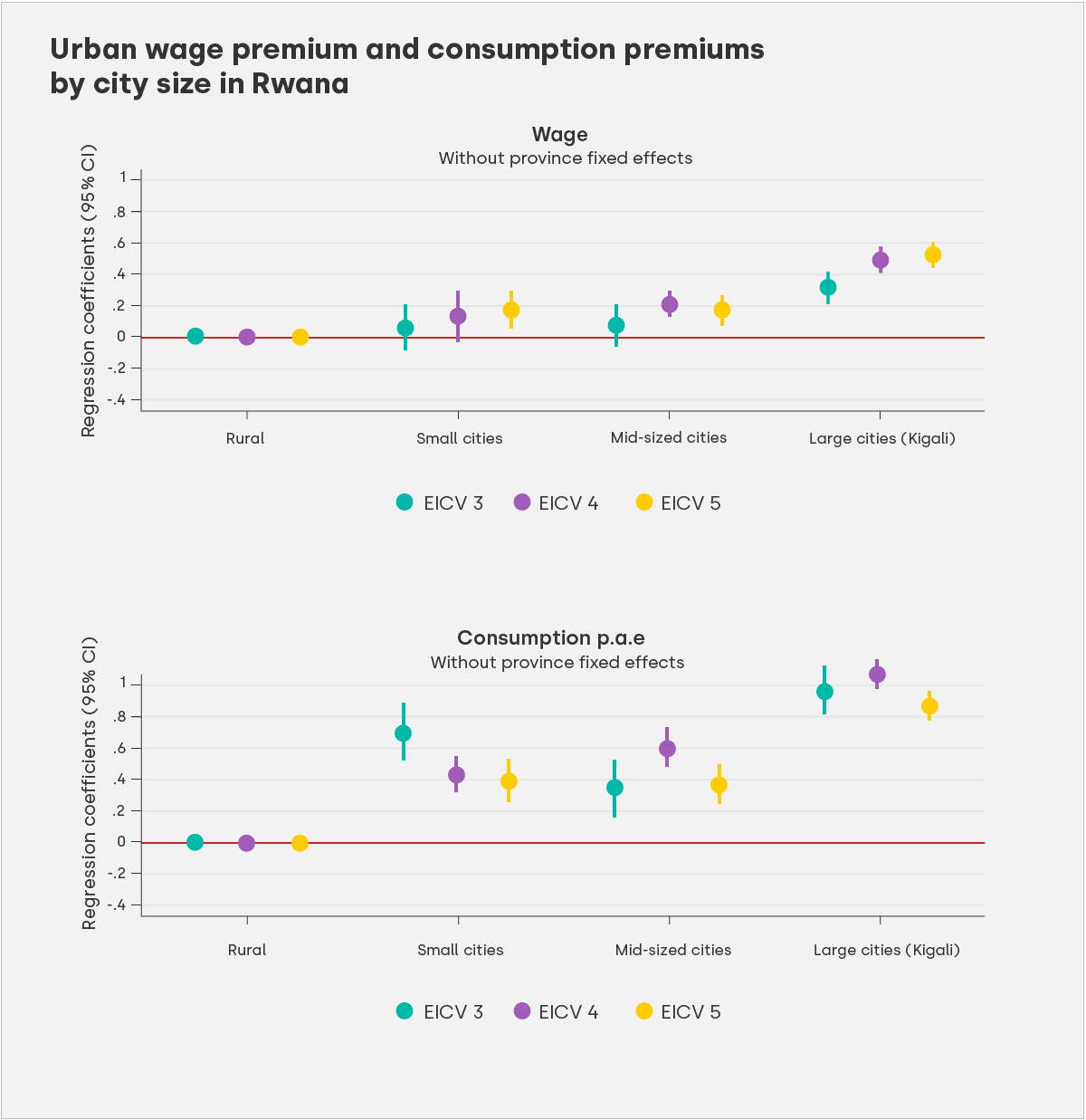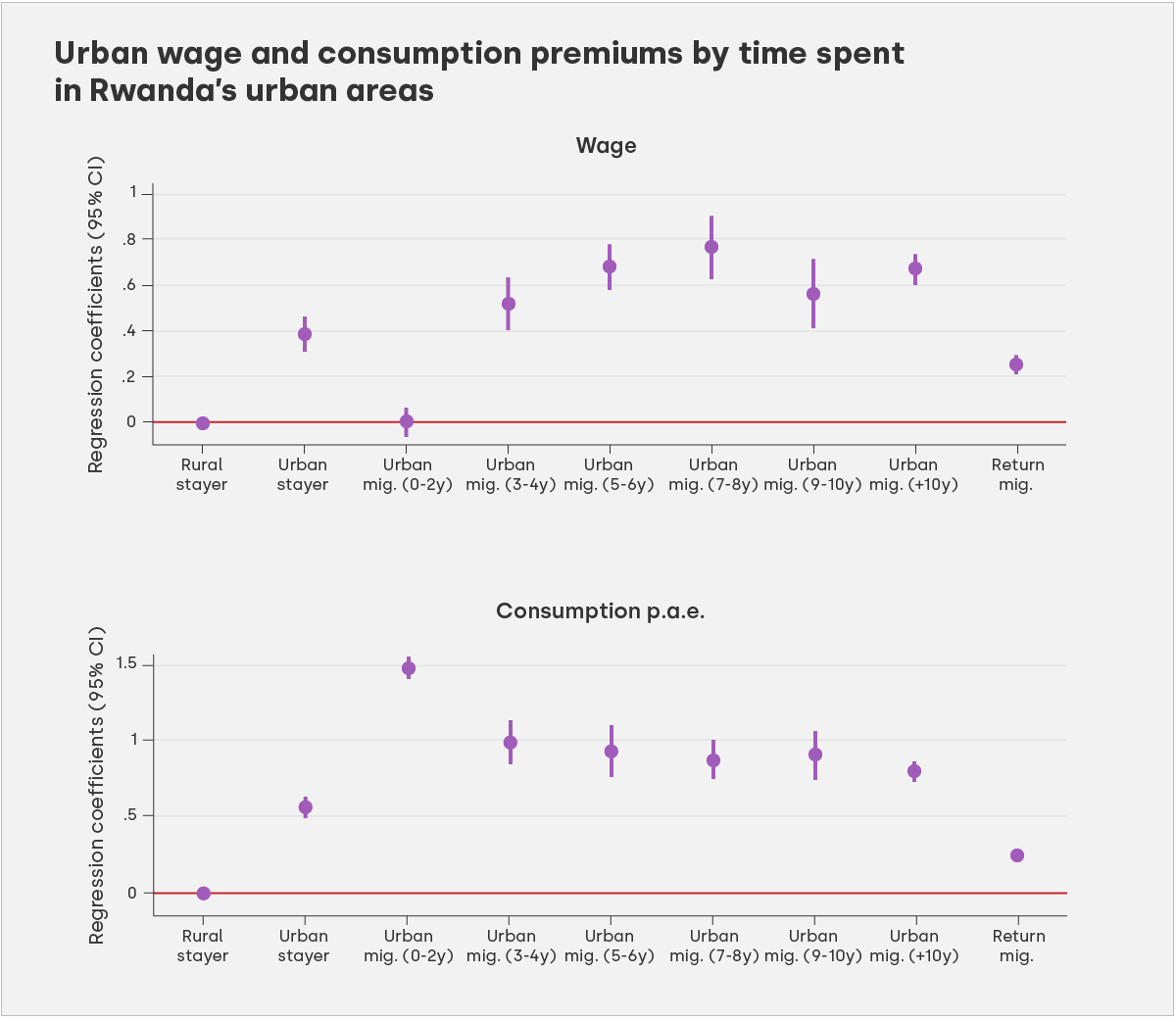
Do Rwanda’s cities increase worker productivity and welfare?
Developing economies are quickly urbanising and must weigh the amenities and disamenities of city life as they grow because the urbanisation process is important for productivity and wage growth.
Rwanda is urbanising rapidly and recognises the importance of urbanisation to overall economic growth. Starting from the current urbanisation rate of 18.5%, Rwanda’s Vision 2050 is targeting a 70% urbanisation rate by 2050. In fact, Rwanda is seeking to harness urbanisation to drive growth through urban investments.
Does urbanisation deliver the anticipated benefits?
African cities face a range of challenges that may harm productivity. They tend to be spatially fragmented with poor levels of accessibility and high costs relative to their level of development. They are also characterised by slow industrial growth relative to cities on other continents. In an IGC study “Is there an urban wage premium in Rwanda?”, we examine urban-rural labour productivity differentials in Rwanda, as well as differences in nominal consumption levels. We investigate whether similar individuals earn and consume more in Rwanda’s cities than they do in its rural areas. We also examine how this compares with international evidence on how cities increase productivity. In our study, we use household data from 2011, 2014, and 2017 in Rwanda with our analysis pointing to the following findings.
Bigger cities have higher wage and consumption premiums
Both nominal wages and nominal consumption are higher in urban areas where the sample includes all employed people of working age (including the underemployed). For individuals with similar characteristics, wages are between 31% and 52% higher in Kigali than in Rwanda’s rural areas, and 13% to 21% higher in Rwanda’s small and mid-sized cities as shown in Figure 1 (These are approximations from log points to percentage). These findings are in line with the correlation between city size and wages found in literature.
We also find that the urban wage premium for Kigali has risen over time from 31% in 2011 to 52% in 2017. It has also strengthened for small and mid-sized cities. The urban premium for consumption per adult equivalent is even more striking from 89% to 110% higher for Kigali and 35% to 72% higher for secondary cities. However, its trend over time is less clear because even if urban consumption levels remain constant over time, an increasing proportion of people living in urban areas has still contributed to an increase in average consumption and reduction in poverty nationally.
Figure 1

Note: “EICV 3” represents the result from 2011 household survey data, “EICV 4” is from 2014 and “EICV 5” is from 2017 (Source: Bower, Gupta & Menon, 2021).
Living in the city longer increases wages
We examine the urban wage premium based on duration of stay in the city and find that urban wages are similar to rural wages for the first two years but increase greatly over time until migrants have been in the city for 7-8 years, as shown in Figure 2. We also find that (self-reported) computer literacy – but not the stated ability to do a written calculation – increases with duration in the city. Taken together, these findings can be interpreted as evidence of a learning effect brought about by living in cities. The longer people live in cities, the more they learn how to increase their earnings through networking and access to new opportunities or through building their education and skills through contact with others.
Consumption does not increase with time in the city
We find that consumption per adult equivalent does not increase with time spent living in the city, which could be attributed to a number of reasons and warrants further research. The findings on wages and consumption imply that those who remain in the city must undergo a period of “investment”, in which they earn low wages and must therefore be supported in a household with consumption levels high enough to sustain them. Their wages do however, generally increase over time pointing to a need for further research on the pattern of resource transfers around the rural to urban migration process.
Figure 2

Note: Urban wage premiums increase with duration of living in the city but consumption does not (Source: Bower, Gupta & Menon, 2021).
Negative urban wage premiums
Including the unwaged in the sample reverses the urban wage premium, in the most recent household survey. This is true and significant for men in all cities except the capital, Kigali. Our main sample includes only those who have worked at least an hour in a week. We then include those who receive no wage in the sample and these people on average make up 5% of the urban population for all three EICV surveys, compared to a rural average of 1%. We find that the urban wage premium turns negative and is significant except for men in urban Kigali in 2017. This is somewhat concerning, but consistent with the finding that many migrants try to move to cities in Rwanda, but fail to find sufficient employment and return home.
Positive urban consumption premiums
Our findings on the urban consumption premium hold just as strongly as before when the unwaged are included, showing that even when the unemployed or unwaged are included, a move to cities significantly increases consumption. It is not clear whether this increase is driven simply by the increased cost of moving to and living in a city or if it signifies that cities reduce poverty.
Urbanisation is good for women
Urbanisation appears to be good for women’s wages and consumption in Rwanda, although not as beneficial as it is for men. On gender, unlike in Uganda, Tanzania and Nigeria, we find that the urban wage premium is statistically positive and significant for women as well as men, although it is 32% to 50% lower for women than for men in Kigali. However, where the unwaged are included, it is always negative and significant for women – but still positive and significant for unwaged men in Kigali for EICV 5 (2017). However, the urban consumption premium is higher for women than for men whether the unwaged are included or not.
Do these results signify improved welfare?
We could not look at real wages and consumption due to lack of price comparison data, which would be valuable if available. One important question is whether Rwandan cities increase real wages and thus have welfare and poverty-reducing benefits for those who migrate. Does the urban nominal wage and consumption premium that we find translate into an increase in real wages and real consumption, and therefore welfare? Do cities reduce poverty? Unfortunately, we are unable to answer these questions in our data, which are purely nominal; we thus recommend the creation of a price index that enables comparison of urban and rural prices.
Trade-off between macroeconomic performance in Kigali and spatial equalising in secondary cities
The main policy conclusion from our findings -- outlined in more detail in our policy brief and working paper – is that major urban investments such as those in infrastructure, would be most likely to maximise poverty reduction and job creation if invested in Kigali. Although, this has to be weighed against the political, spatial justice and – perhaps – social cohesion-related benefits of investments in secondary cities. Rwanda’s Vision 2050 encapsulates the country’s serious political will to end poverty and to sustain national growth rates to become an upper middle-income country by 2035 and a high-income country by 2050. However, the government also wants much more equitable and widespread economic growth in secondary cities as shown in the National Land Use and Development Master Plan 2020-2050 as well as other similar initiatives. Both are important and ambitious visions, but this research highlights that there may be a potential trade-off between them. This trade-off should be internalised during policy dialogue on the implementation of these plans, and when taking major spatial public investment decisions.

